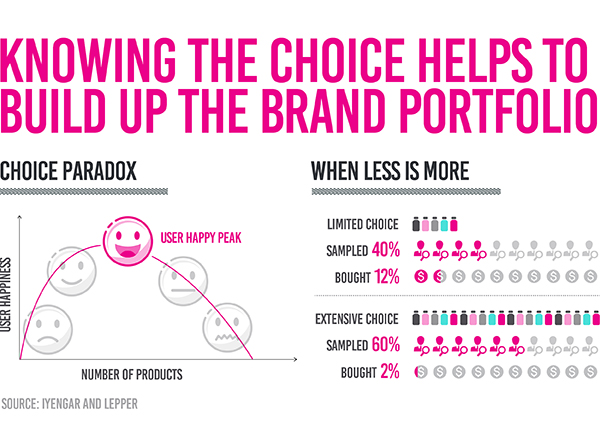![]() 6 minute read
6 minute read
The well-identifies cross-selling has always been a sure way to grow the revenue. The secret of the great match is defining the basket case. Nowadays, there is an opportunity to digitalize the shopping patterns and have a real-time basket analysis. Can we do the same thing for the future relying on historical data or it is not enough?
The paradox
of choice
Global trends for change spillover from the demographic, geographic, technological, and generational perspectives. After the industrial revolution market becomes overstuffed with a variety of products and services. Moreover, the www-world opened the doors for an unlimited number of goods resulting in access to a variety of options all in one time. The ability to choose a product from all over the world seems like a heaven. As proven by multiple studies, the choice makes people happier. The liberation to choose a product or service gives customers an illusion of control, increases their motivation and satisfaction levels. However, there is a catch.

The choice that has a positive impact should not be limitless. As Sheena Iyengar, the S. T. Lee Professor of Business in the Management Department at Columbia Business School and the master of choice theory shows with her studies, the more choice people have less decisive they become. According to her experiment at Draeger ‘s Market, “we want more choice presumably because of all the opportunities it provides us. But when it comes down to making a choice, we don’t want that choice to be too hard or too conflict-ridden or too burdensome.” Procter and Gamble ran similar experiments that showed a 10% revenue increase by decreasing available choice of any given product. Thus, for the sake of sales, the limitations for the customer’s basket shall be enabled. Trader Joe’s and Lidl lead this successful example in the different continents in the grocery retail industry. Having most of the product selection under the private labels and offering the variety by taste and function.
E-basket
case
This year’s Cyber Mondays sales have overgrown Black Friday sales in the US bringing $7.9 billion in revenue.“Cyber Monday sales topped $7.9 billion according to Adobe Analytics data, making it the single largest shopping day in U.S. history,” said John Copeland, head of Marketing and Customer Insights at Adobe. “Sales coming from smartphones hit an all-time high of $2 billion and we saw a significant spike in the Buy Online, Pickup In-Store trend.” E-Commerce has an opportunity to have a real-time analytics about basket data. One of the first digital innovations came from e-commerce with the recommendation of people-like-you methodology. These developments have added new opportunities of not only witnessing the structure of the basket but also actively contributing to it. Thus, Anticipatory Shopping from Amazon is utilizing the predictory shopping patterns and generates 35% of the revenue through recommendations. Having the product variation visibly decreased by recommendation challenges the paradox of choice.
According to IDC report, almost 30% of all data will be generated real-time. Thus, it is important to see companies that are able to provide the results in real-time already today. For instance, Apache products focus on computational and processing systems to handle and analyze inputs of diverse consumers. It allows to group products in new up-to-date categories and highlight goods via personal preferences. Amazon, Twitter, and LinkedIn utilize Apache Kafka open source platform for their users’ data analyses. Real-time analytics gives an access to profiles of Black Friday shoppers. For instance, Bluecore reports that first-time buyers have purchased 57% of goods, and at least half of them will become repeat buyers. This group hit it most on the jewelry, apparel and footwear retailers.
“Though retailers see a significant number of first-time customers on Black Friday, the winners will be those that are able to convert these new shoppers into valuable long-term customers. Even more significant than total Black Friday sales numbers is the number of first-time buyers that become repeat buyers over time,” said Rob Holland, COO, Bluecore. “This year we saw an average of 57% of purchases coming from new customers. We expect that more than 20% of these new customers–who often convert in response to higher-than-average discounts–will become second-time buyers in 2019, and will buy in response to lesser (or no) discounts.”
The development
of nutrition for next decades
Future of food basket entails the polarization. First, the increasing demand for highly nutritious products that are sustainably produced and easy to cook. The global dietary market will reach $220.3 billion in 2022 with a growth at a CAGR of 8.8% between 2017 and 2022. Similarly, the protein ingredient market grows at the same pace. Nevertheless, the other end of the curve offers enriched flavors and prioritizes the taste. This is illustrated by the growth of spices and seasonings market at a CAGR of 6.0% during 2018-2023 reaching $30,412.8 million.
Moreover, there is more attention on the nutritious characteristics of the food. According to the World Health Organization, in 2009 there was 2,831 kcal available per capita per day. The organization predicts that by 2050 the number will decrease down to 2,026 kcal which is below the nutritional threshold. The composition of the food basket depends on the availability of products, affordability, acceptability by culture and religion, and utilization by lifestyle and culture. In recent decades, global food crops prices have been increasingly fluctuating. Areas that rely on the import of goods felt the impact particularly noticeable. Thus, in the future, governments plan to develop local access to food. Therefore, the developments of urban gardens and urban farms gain popularity.
Affordability is as well an important factor in nutrition prediction. As the global middle class is rising there is a similar trend on the obesity levels around the world. Also, the increase in food consumption causes a spike in the consumption of higher quality products. This translates in the short-term accessive food consumption and in a long-term settling for the new lifestyles. Moreover, the utilization is one of the biggest drivers of consumer values. Utilization differs on the local habits and value systems. Thus, it is important to pay attention to the cultural setting and the on-going trend. On the other hand, the acceptability factor is one of the most stable as it is derived from long-standing cultural and religious characteristics.




